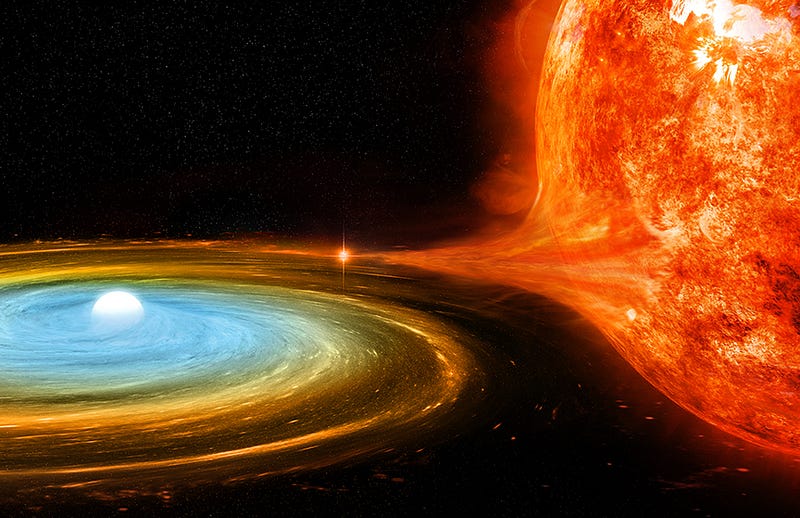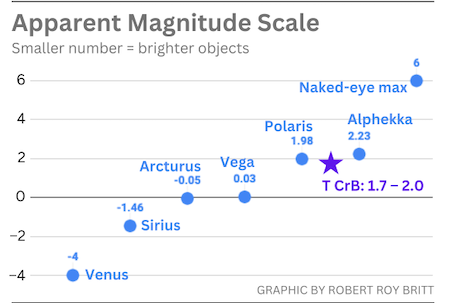A Rare Cosmic Event: The Anticipation of a New Nova in 2024
Written on
Understanding the Upcoming Nova
Most individuals have yet to witness a nova, but the universe is about to present a stunning display in the night sky. This event is anticipated to unfold before the year concludes, provided the conditions align.

In this illustration, a red giant star (on the right) is shedding hydrogen towards a small white dwarf companion. As gas accumulates, the pressure and temperature rise, leading to a brilliant nova explosion. Source: NASA/CXC/M. Weiss
By the end of 2024, a new star is projected to illuminate the night sky, only to fade away as quickly as it appears—perhaps akin to binge-watching the first six Star Wars films. Stargazers in the Northern Hemisphere stand a good chance of witnessing this stellar phenomenon, known as a nova. Experts predict it will shine brighter than most of the stars visible from Earth.
While it may be referred to as a new star, it’s more akin to a returning performer. However, there’s a possibility that the star’s appearance may be delayed, potentially for months or even years, as novas can be notoriously unpredictable.
A global community of astronomers—both professional and amateur—eagerly anticipates the imminent eruption from the binary star system designated T Coronae Borealis, or T CrB for short. This duo last exhibited their brilliance in 1946. Since then, they have been quietly orbiting each other, located 3,000 light-years away and too faint to be seen without aid during their dormant phases, which typically last around 80 years.
When this nova does appear, it will resemble any other star to the naked eye. However, the astrophysics behind this explosive event are captivating, and witnessing one is a rare opportunity. Over the last two decades, only five novas have been bright enough to be seen without telescopes or binoculars, and this was only possible for observers in locations with minimal light pollution.
In contrast, T CrB is expected to be a luminous spectacle. "T CrB will be the brightest nova event of the last two generations, likely remaining the brightest for the next two generations," stated Bradley Schaefer, an astronomy professor at Louisiana State University.
While there’s no ticket price for this cosmic event, some preparation is advisable. The nova will likely appear without warning, shining brightly like Polaris, the North Star. Observers will need clear skies, and darker locations will enhance visibility. People residing in urban areas with significant light pollution may struggle to locate the nova amidst the surrounding stars.
Your backyard could provide a prime viewing spot. Just about anywhere in the Northern Hemisphere with a clear view of the sky will suffice. However, taking some simple steps beforehand can greatly improve your chances of spotting this celestial highlight.
The following sections will guide you through:
- The formation of novas
- Differentiating between novas and supernovas
- Anticipating the nova's arrival
- Preparation tips
- A guide on locating the nova
How Novas Are Formed
The excitement surrounding this event is amplified by understanding the celestial bodies involved in this stellar performance.
A nova typically arises from two stars engaged in a gravitational dance. Binary star systems are prevalent in our Milky Way galaxy, and the T CrB pair has been in this cosmic waltz for billions of years, occasionally interrupted by explosive outbursts.
The dominant star in T CrB is a red giant, a phase our sun will eventually enter. The companion star is a white dwarf, the final stage of a red giant’s life cycle, having exhausted its nuclear fuel and collapsed into a compact, Earth-sized remnant with a mass similar to that of our sun.
Though the white dwarf is mostly inactive, it can still be revived. It draws in gas from its red giant partner, leading to an accumulation of material on its surface.
"The ultra-dense white dwarf can siphon material from its companion star through a process known as accretion, which causes a layer of hydrogen to accumulate," explained Mark Hollands, an expert on white dwarfs at the University of Warwick. "Once enough material has built up, it reaches a critical temperature, triggering hydrogen fusion. This nuclear explosion ejects gas from the surface of the white dwarf in a brilliant shell."
Despite the surface gas being expelled, the core of the white dwarf remains intact, ready to undergo the cycle again.
Most novas take thousands of years to reawaken, with only ten known cases in our galaxy that revive within a century, according to Schaefer.
Distinguishing Novas from Supernovas
It is crucial to note that novas are distinct from supernovas.
Novas shine intensely for a few hours or days and then dim, returning for future eruptions, whereas supernovas obliterate stars, leaving behind a stunning nebula and, occasionally, a black hole.

The Crab Nebula, an expanding cloud of gas and dust resulting from a supernova explosion. Source: NASA/ESA/ASU/Allison Loll; Jeff Hester; Davide De Martin
The impending eruption of T CrB also presents a rare opportunity for astronomers to study a cosmic phenomenon that is seldom predicted. They will analyze not only visible light but also other forms of electromagnetic radiation using a variety of telescopes around the globe and in space.
"Novas produce a spectrum of electromagnetic radiation, ranging from radio waves to X-rays," noted Koji Mukai, an astrophysics researcher at NASA’s Goddard Space Flight Center. "To fully appreciate the event, we need to capture the entire range, akin to experiencing a complete symphony rather than just an octave."
When T CrB erupts, it will be a unique chance to witness this full spectrum of cosmic music, partly due to its relative proximity and brightness, as well as advancements in observational technology.
When Can We Expect the Nova?
The nova T CrB will manifest in the constellation Corona Borealis, also known as the Northern Crown.
Eruptions of T CrB have been documented for centuries. Observations prior to the 1946 explosion showed the star brightening for several years, then dimming shortly after the eruption. A similar pattern has been noticed recently, indicating that another eruption is near.
Currently, we find ourselves in the middle of a high-probability window lasting six to eight months. As T CrB has not yet erupted, it is expected to do so by the end of summer, according to Schaefer. Despite uncertainties, he believes “an eruption before the year’s end is very likely.”
However, there remains a chance that astronomers might be surprised, as T CrB has a reputation for being unpredictable.
"Recurrent novae often defy expectations," Mukai remarked. "Just when you think they will follow a certain pattern, they often diverge from it."
The eruption could occur as soon as September, but Mukai suggests, “A more reliable prediction is that it will happen any time between now and the end of the decade.”
Preparing for the Event
Individuals living in urban areas with significant light pollution may find it difficult to see the surrounding stars that will help locate the nova.
Good news: Any star appears brighter when positioned directly overhead due to less atmospheric interference. Schaefer anticipates the nova will peak between magnitudes 1.7 and 2.0, potentially shining brighter than Polaris.

The brightest star in the sky, Sirius, is visible only from the Southern Hemisphere, while Arcturus shines brightly for those north of the equator. The expected brightness of the T CrB nova is an estimate for its peak.
With so many astronomers monitoring for the nova, social media will likely be flooded with reports of its eruption shortly after it occurs.
To ensure you’re ready to witness this phenomenon, consider these tips for preparation:
- Familiarize yourself with the area of the sky where T CrB will appear.
- Utilize binoculars to help identify fainter stars, especially in light-polluted areas.
- Use a stargazing app like Star Chart, which allows you to point your phone at the sky to identify stars.
Finding the Nova: A Guide
On a clear night, preferably when the moon is not full, venture to the darkest location you can find, away from artificial lights.
Allow your eyes to adjust to the darkness for at least 15 minutes. Start by locating Arcturus, the brightest star in the Northern Hemisphere. If you can find the Big Dipper, trace the arc of its handle towards Arcturus.
Next, locate Vega, the second brightest star, using a map for assistance. Once you have identified these stars, find Alphekka, which lies along the line between Arcturus and Vega.
If your skies are sufficiently dark, you’ll be able to see the horseshoe-shaped constellation Corona Borealis. When the nova appears, it will be just slightly away from the horseshoe, making it easier to locate when it erupts.
If T CrB reaches its predicted brightness, it will outshine Alphekka. If visibility is hindered by light pollution, consider scouting for a darker viewing location.
While spotting the nova may not be as dramatic as witnessing a total solar eclipse or an extraordinary display of the Northern Lights, it represents a rare chance to observe an event that may not recur in your lifetime.
“While a few recurrent novae have short cycles, typically we don’t witness repeated outbursts within a human lifetime, especially one that is relatively close to Earth,” remarked Rebekah Hounsell, a NASA Goddard assistant research scientist. “It’s incredibly exciting to have this front-row seat.”
Gather your friends and family, and don’t miss this extraordinary cosmic event whenever it occurs.
Fun Fact: Although T CrB has already erupted, it takes 3,000 years for its light to reach us, meaning we will witness an eruption that happened long ago, shortly after the ancient Egyptians devised sundials.
As a former editor-in-chief of Space.com, I am genuinely excited about the opportunity to observe this nova. While it may not serve any practical purpose for most, it offers a philosophical reminder of our smallness in the cosmos. Join me in following this celestial event and other skywatching opportunities by subscribing to Aha! Science for updates on this and other fascinating scientific news.
Chapter 2: Video Insights
In this video, 'New star event to create once-in-a-lifetime sight in the sky,' viewers are introduced to the upcoming nova and its significance in the cosmos.
In the presentation titled 'Nova T Coronae Borealis: A New Star in the Crown,' Mansi Kasliwal discusses the details surrounding T CrB and what to expect from this celestial event.